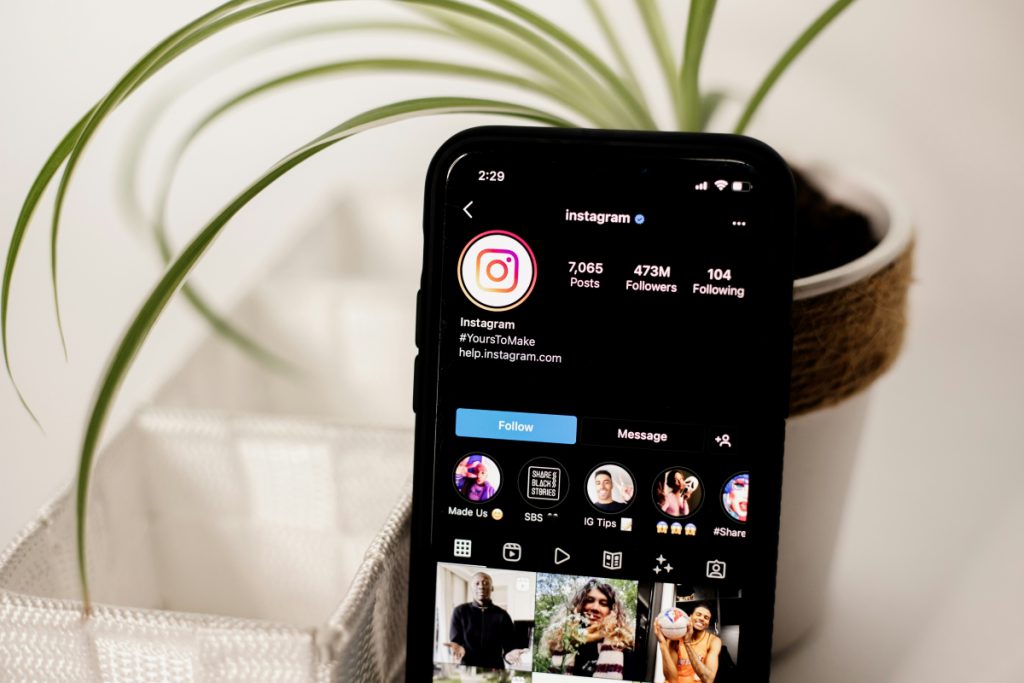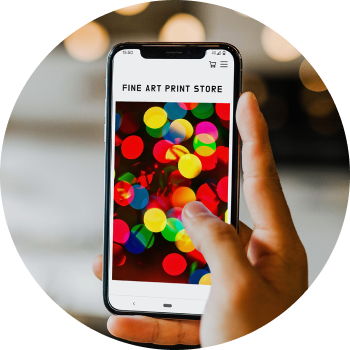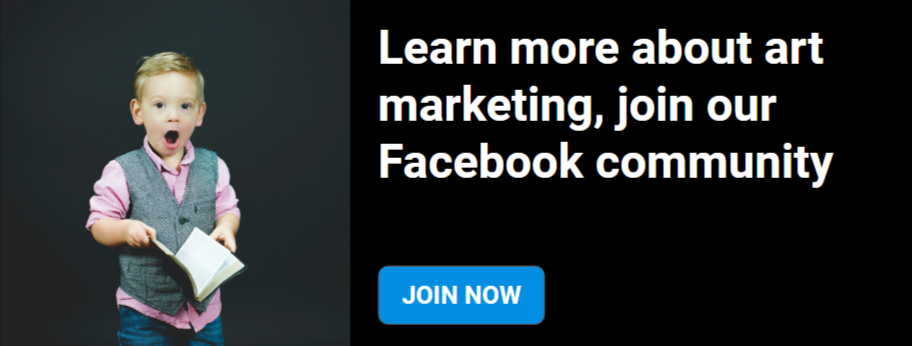
Adding context to your work is like the score to a film or a music video, it helps create the vibe and gets people emotionally engaged in your work. And that will help your career and your sales.
When researching this article I realised that very few artists do this really well. This is maybe because reaching your audience directly on social media is relatively new for artists, and they have not fully learnt how to express the context surrounding their work, and there are many misconceptions about what this means; for example that it’s about putting your personal life online or explaining the meaning to your work. It is neither of those things, something we will explain in this article.
Most people if they love a creator of some sort, like a musician or a band will know a reasonable amount about their life and influences, how they came to make the work, where they lived, their backstory, their family and relationships, some of their public statements and events in their lives.
Why does knowing anything about them matter? The reason is that it gives context to the creative output. Knowing something about the creators of important works of human creativity or understanding deepens the connection to, and the understanding of the work itself. This is why people read autobiographies.
For visual artists this is also true. Of course we can appreciate and understand visual art without knowing anything about the artist, but we can relate to it better when we do. If we did not know Andy Wharhol came from New York in the 60s, the centre of the advertising industry, would his Campbell’s Soup Cans have been fully understood in the same way?
What do we mean by context?
The subject of context is not straightforward however. Context does not necessarily mean putting out posts about yourself and your life. It could be that but there are plenty of other ways of contextualising work and that depends on your work, you and what matters in terms of how your work comes about. The way you add context is as personal and individual as the work itself. The best way to understand this is to look at some examples of how other artists are doing it.
Let’s start with Banksy for example. On first glance it would be easy to assume there’s no context to his work because he’s anonymous. However there is a ton of contextualising information out there. We know he is a pioneer of the street art scene, from the Bristol area. Anonymity is a statement in itself, creating intrigue and it makes sense in terms of the work as graffiti artists would often be arrested for criminal damage, more so before it was more fully accepted as an artform. Anonymity is also a statement about the often politicised or humanist nature of his work. This plays into the heritage of stencil graffiti which has often been used for political, revolutionary messages, messages of dissent or commentary on daily life. So his context is there and it really matches the work, and it’s clever in the sense that it says a lot through what it doesn’t say.
We will start looking at some examples of artists who add valuable context, but before we do we will lay out some statements of what we believe in terms of adding context:
- Adding context doesn’t mean explaining what your work means. Usually this is advisable as it deprives the viewer of the agency to interpret it themselves.
- Also, it doesn’t mean putting yourself forward personally, as an influencer does, unless of course that is an important aspect of the work. This gets confused on social media because it has become so synonymous with influencers. However, Tracy Emin’s work is very personal, so knowing who she is and certain aspects of her life makes sense in order to contextualise it.
- Context can exist in a very minimalist way or even in an empty space, again if that makes sense to the work…but this is way harder to achieve. Sometimes the work itself does the heavy lifting, whereas other work needs more contextualisation.
- Context could be anything. It could be something that is seemingly unconnected to the work, context does not have to be connected to the work in a linear way. Contextual information usually works best and is most memorable if it is delivered in the form of a story.
- Context is unlikely to make sense if it is not authentic and honest.
- Most of the things people do that are successful are things that are natural extensions of their personalities and what they love to do or believe in passionately. In other words, their art or creative thinking was born out of their personal context.
There are some things we think you need to start contextualising your work:
- Your need to have some sense of your why, i.e. what makes you do what you do. If you do not have any sense of this, then we advise reading Start With Why? By Simon Sinek.
- To look at the examples we have provided below of artists who contextualise their work effectively on Instagram. This will help you get started. That doesn’t mean you are copying what they are saying, but rather you are getting ideas on how to express your context.
- Be brave enough to be honest & authentic. Go gently at first and put some things out there. Remember they don’t have to be hyper-personal, unless that is what the work needs. See the response in terms of the comments to see if the context has resonated with your audience.
- Be open to working on this. Unless you have already achieved all your goals, or you are well on the way to achieving them then try to avoid thinking ‘my work is enough, I don’t need to add context’. This is rarely true, and usually is true when someone is high profile enough to have other people, journalists or bloggers, to contextualise their work for them.
Examples of context from artists on Instagram
Jonas Peterson
One of the best examples for someone who is great at contextualisation of their work is Jonas Peterson. Jonas has had many careers; advertising, creative direction, copywriting and photography. He has always approached his work through the lens of storytelling. One formative experience for him happened when he started writing a blog back in the early 2000s. Just after starting writing it, he experienced the bereavement of a close friend. As a result he started writing very open, honest and emotionally raw posts in response to this. Suddenly he had hundreds of thousands of readers for the blog. He found this emotional expression and rawness ended up really striking a chord with people, and helping them through their own situations. I.e. it created connection, which is one of the things an artist might be seeking to do. This now feeds into how he contextualises his work as an artist. Here’s a few posts he has done.
For me the words have a connection with the work. Not all the stories are long and personal however:
His words have a real deep genuineness and honesty about them. For me, whatever you write has to come from a place of genuineness; i.e. something you really feel. Having met Jonas and chatted at length many times, I can safely say authenticity is the key. His work is deeply humanist, and his stories reflect that.
Lily-Rose Burgess
Lily-Rose Burgess is an Australian artist whose beautiful vivid bright paintings can be both nostalgic or simply observant of the simple but cherished moments in everyday life. The context she writes in the captions reflects this about her work, in the form of stories of how the work came about or what she likes or feels about the scene she has painted.
Reuben Wu
Reuben Wu merges the realms of landscape photography and light art to create beautiful, surreal and otherworldly scenes. His work often features natural landscapes illuminated by striking, geometric light forms that he terms as Aeroglyphs. These light installations introduce a futuristic and mystical element to his photographs, transforming ordinary landscapes into extraordinary visions. He talks about his journey to this stage of his career, how he feels when he makes the work, and why he makes the work he does.
Flower Press Studio
Flower Press Studio makes artworks that are an expression of Keith and Rachel’s lifestyle and beliefs; it is mission driven art that celebrates the beauty of nature and their respect for it and the sustainable communities around it. Their artworks evoke a sense of tranquillity and appreciation for the natural world, highlighting the beauty and diversity of flora. They add some context on themselves, their beliefs, where they live, and their local community and the process of making their work which is a meticulous process over many months to create the end result.
Andrew McCarthy
Andrew McCarthy is known as Cosmic Background. He is a backyard astrophotography artist, capturing the vast and mesmerising beauty of the universe from his backyard in Arizona. He makes work inspired by his wonder for the universe and his context really shows this. He has a unique aesthetic style that really shows the beauty of the night sky and its awe inspiring scale. His context in his posts really reflect his passion for the subject and it’s really infectious.
I think this reel was such a great example of highlighting his passion for his subject.
Types of context
There is a sliding scale here, in terms of context. At one end you have zero context, in the middle you have context that simply explains why the artwork was made, how it was made etc and then at the mastery end you have emotionally articulate context that resonates deeply with people. Your job as an artist is to work your way up that scale with some of your posts. You needn’t always be saying really deep things, but if you have the ability to do that, you will create a deeper connection for people to your work.
We have made a list below of possible contextualising posts for artists. These are only suggestions, not a list of things you should post. You need to post what makes sense to you and your work. What does that mean? If it is a significant event or story in your life, or it is significant to the way you find your ideas or make your work, then it is context.
Here’s that list of examples, and please note that the visual element of the post doesn’t have to be about the context, the context could be purely contained in the caption.
- A picture of your studio. Showing the place where you create your work will help people imagine what it’s like to be a fly on the wall when you are in creative mode
- Images from an exhibition you visited, or a post of an art book you just bought. Knowing your influences and what you like helps people to understand your work.
- A story from your career. This could be a breakthrough you made, and how it came about. It could be some words of encouragement someone gave you, or how you
- A work in progress video. Seeing how you create your work can be a really useful context for your followers.
- A random story that is posted with some work. Your stories do not have to have any obvious connection to the work. If something interesting that happened is on your mind, then express it in the captions. The chances are it can have some very subtle connection to the work.
- A story about the culture you are immersed in. This could be a geographical culture, for example where you live could have some clear effect on how you think or what stimuli you are exposed to. It doesn’t have to be geographical, it could be music, a subculture, a community etc. that you are closely involved with.
- A story about how you get your inspiration. Is there a process that leads to your ideas that would be worth sharing? Maybe you don’t have to literally explain how you got an idea, but you could tell a story of something you did or somewhere you went, and then in the captions say ‘it was whilst doing this the idea for artwork X came to me’
- How are you feeling or how were you feeling when you made the work, or how does the work make you feel, or how do you want others to feel when they see it? This doesn’t have to be something really personal, but it should be honest and well articulated.
Context can be anything you want it to be; it’s the things that contribute to your work in a direct or indirect way. The context you express does not have to feel or even have any obvious connection with your work, the connection can be very subliminal. Ultimately with art, there doesn’t need to be any direct one to one causal relationship with who you are or anything you do or experience and what you make. What all the examples above have in common is that they do express something, something that the artists have an interest in saying.
As mentioned above, context can be minimal but effective. It is worth noting that for some work the titles and content of the work alone can be context. One of my personal favourite artists is Mars Black, and I think he is an example of this.
Ultimately, why should you care?
Images are becoming easier to make, with the advent of generative ai. However, making images is not the same as making art. People often ask us if generative AI will undermine the art industry and our position on that is that it will make it stronger. Art is the expression of a life that has been lived, experienced, and felt and is a culmination of all those thoughts and experiences in an expression of a body of work, or a lifetime of work for many artists. The fact that images get easier to make throws into stronger contrast the difference between art and images.
We need art more than ever, but without the context, how do we understand the work? You may know the context, or you may not yet have ‘joined the dots’ in reverse and you might have to spend some time understanding your own motivations or influences. We urge you to start doing that, for the sake of your work and all the effort that went into making it, and you. The happy side effect of doing that is you will sell more of it. Theprintspace runs an agency that helps artists drive monetisation and online art sales and in this agency we see a clear correlation between putting context out there, and sales.
Join our group and tell us your opinions on context. Also, do you have some ideas about what context could or should be? Join the conversation!




